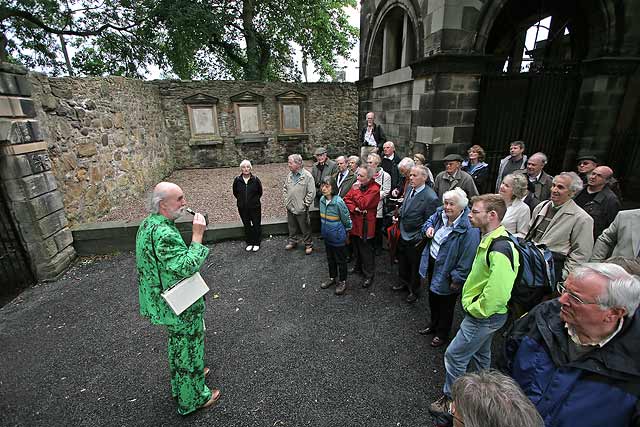|
(A)
Rock House Studio
-
Rock House was
beside the steps leading up to Calton Hill from Waterloo Place, about
1/4 mile to the east of the East End of Princes Street.
-
This studio
was used by Hill & Adam, calotypists, in 1843-47, then by a succession
of other photographers over the next hundred years.
Rock House
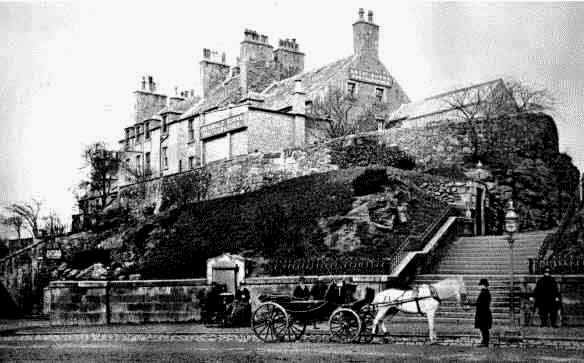
©
Reproduced by courtesy of
Edinburgh City Libraries and Information Services
Hill & Adamson
Rock House
1843-47
-
Here are a few of the many calotype photos that have
survived from the studio of Hill & Adamson at Rock House.
-
The Scottish National Portrait Gallery in Queen Street
has a large collection of Hill & Adamson calotypes and has published
books about this collection.
D O Hill
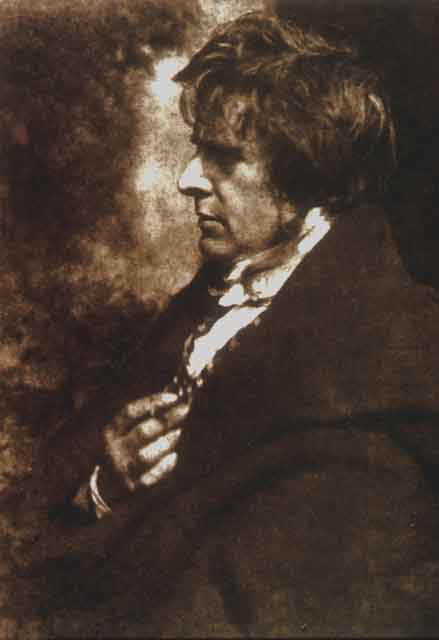
©
Reproduced
by courtesy of Edinburgh Photographic Society
Newhaven Fishwives
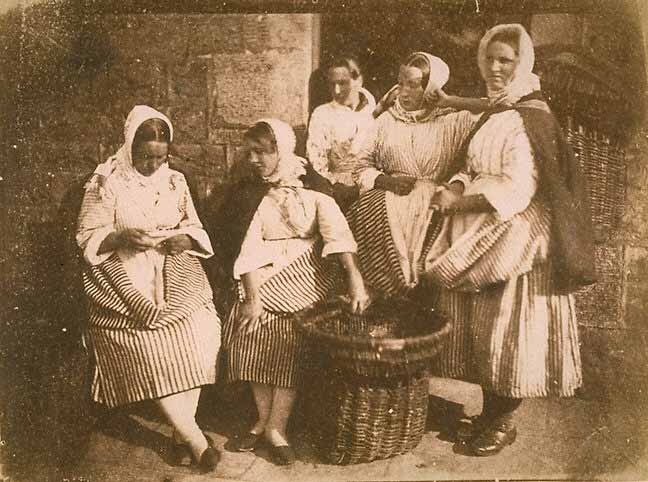
©
Reproduced by courtesy St Andrews
University Library
ALB6-92
The Scott Monument
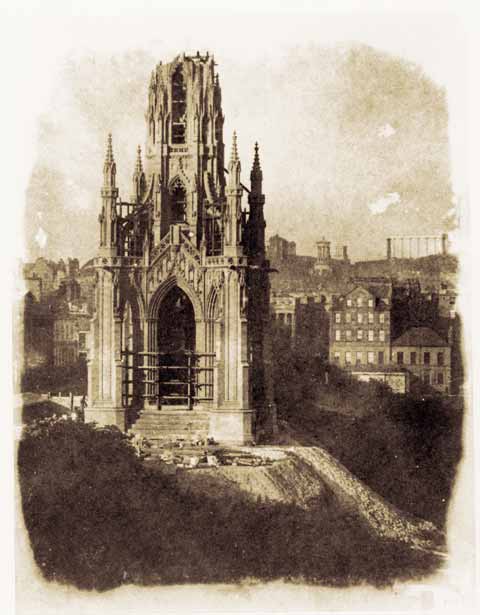
© This photograph is included with National
Galleries of Scotland permission. See
Copyright Conditions
White Horse Close
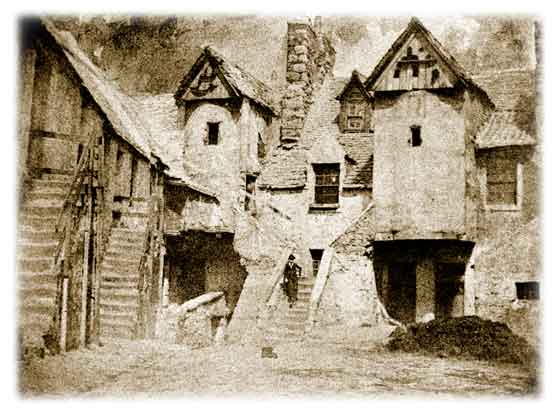
© This photograph is included
with National Galleries of Scotland permission. See
Copyright Conditions
________________________________
(B)
Salisbury Place Studio
Kenneth McLeay RSA
Photographic Studio: 1859-63
Kenneth McLeay
by Hill & Adamson
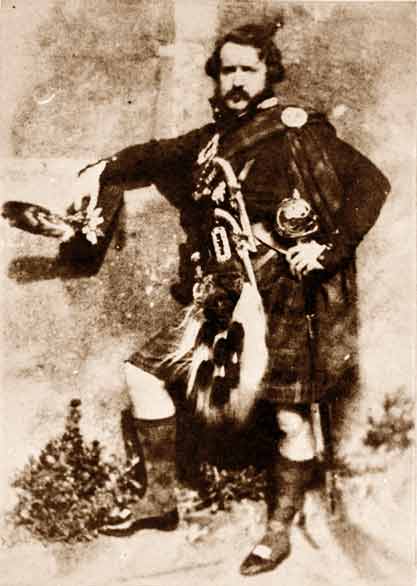
©
Reproduced by courtesy of
Edinburgh City Libraries and Information Services
|
Kenneth McLeay's
Price List |
|
Plain Photographs
1st size - no hands
10s 6d
2nd size - with hands
15s 0d
3rd size - half length
£1 1s 0d
4th size - whole length £1
11s 6d
Plain copies of the first 3 sizes - 5/- each
Plain copies of the 4th size
- 7/6 each.
Painted Photographs
1st size - tinted
£2 2s 0d
1st size - finished £3 13s
6d
2nd size - tinted £2
17s 0d
2nd size - finished £4 19s
0d
3rd size - tinted
£3 13s 6d
3rd size - finished £6
6s 0d
4th size - tinted
£5 15s 6d
4th size - finished £8 18s
6d
4th size - in uniform or highland dress £10 10s 0d
Miniatures for Bracelets, Lockets, etc. - smallest size £6 6s 0d
|
|
NOTE: £1 in 1859 is equivalent
to almost £100 in 2010.)
|
________________________________
(C)
Princes Street Studios
Edinburgh Studios - 1840 to 1900
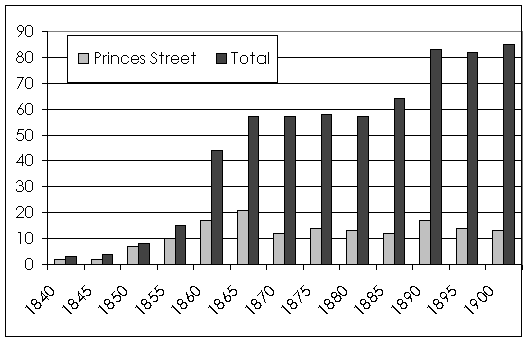
-
Princes Street
was well suited to photography. There was an open outlook to the
south towards Edinburgh Castle, so studios on the upper floors in
Princes Street got the good light that was needed for photography in
the early days.
-
There were
many tourists and local residents passing along Princes Street, who
might visit the photographic studios - but not many would have been
prepared to pay the high cost for photos in the early days.
-
Talbot had
patented his Calotype photographic process in England, and Daguerre
had placed restrictions on the use of his Daguerreotype in
England, but photographers in Scotland were free to use either
process.
Cartes de Visite
See also 'Further Notes'
Most Edinburgh photographers started selling:
- cartes de visite between the late-1850s and
1900, then also
- cabinet prints between the late-1860s and
1900.
Here are a few cartes de visite from Edinburgh
studios:
James Ross
Studios: 1846 to
1870
Cartes de visite: Newhaven Fishwives
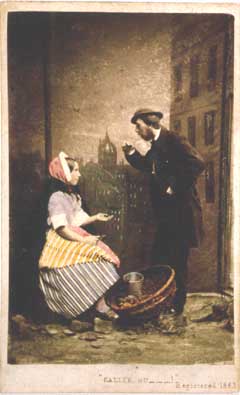
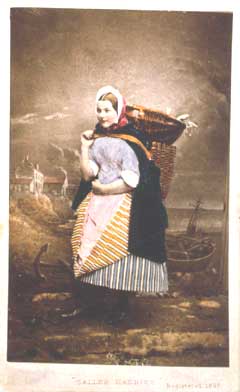
©
Reproduced with acknowledgement to National Galleries of
Scotland permission.
John Ross
Studios: 1858 to
1900
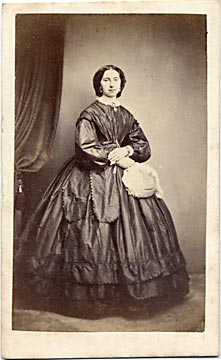

©
peter.stubbs@edinphoto.org.uk
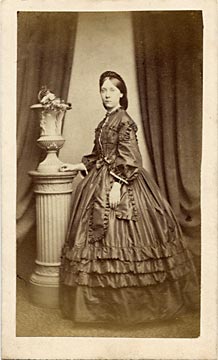
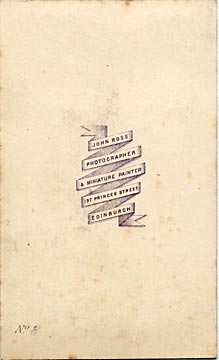
©
peter.stubbs@edinphoto.org.uk
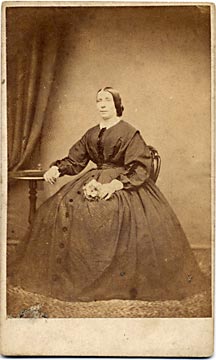
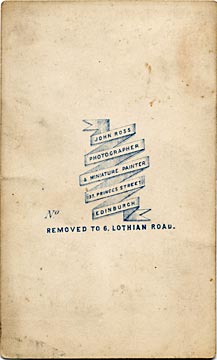
©
peter.stubbs@edinphoto.org.uk
John Moffat
Studios: 1853 to
1962
Cartes de visite
showing medals awarded to him
1875-80


©
peter.stubbs@edinphoto.org.uk
1882-86
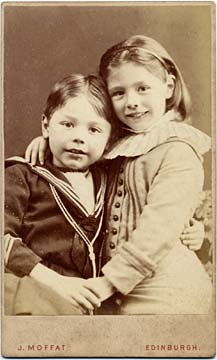
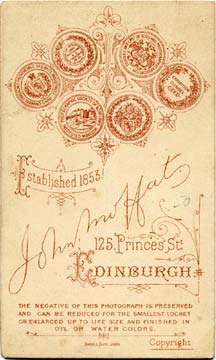
©
peter.stubbs@edinphoto.org.uk
1890-97


©
peter.stubbs@edinphoto.org.uk
From 1897

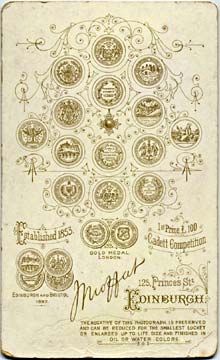
©
peter.stubbs@edinphoto.org.uk
James Howie
Jun
Cartes de visite: 20 men:
Cowgate Free Church Choir
Cartes de visite: 42 men: Who are they?
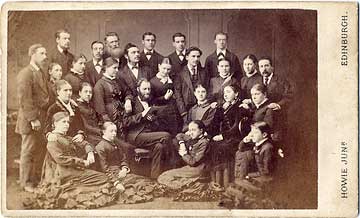
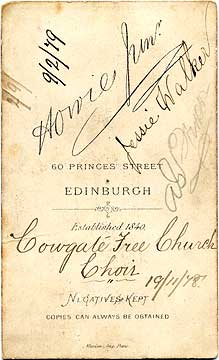
©
Reproduced with acknowledgement to the
Scottish Genealogy Society
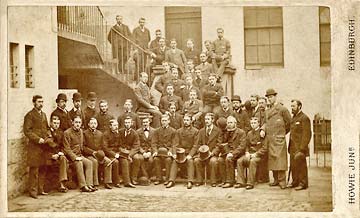
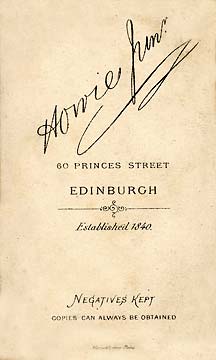
©
Reproduced with acknowledgement to the author of www.cartedevisite.co.uk
The Cost
See also 'Further Notes'
-
A typical charge for cartes de visite in the 1860s
was about 6 shillings a dozen - equivalent to about £25 a dozen
in today's money, in 2010.
Cabinet Prints
See also 'Further Notes'
Parisian Photo Co
Studio: 1887 - 1914
Cabinet Prints
-
I believe that all the 'Parisian Photo Co' photos
below are likely to have been taken between about 1887 and 1905:
-
These photos all
have backdrops, suggesting grander or more exotic surroundings than the
sitter might have been accustomed to. But they are obviously studio
shots. e.g. where the photographer has made no attempt to hide
join of the backdrop and the flooring.
-
A couple of the
people in the photos are in uniform. Did these uniforms belong to the
studio? I suspect the answer is 'Yes' - at least in the case of the
Fire Officer's uniform.

©
For permission to reproduce, please contact
peter.stubbs@edinphoto.org.uk

©
For permission to reproduce, please contact
peter.stubbs@edinphoto.org.uk

©
For permission to reproduce, please contact
peter.stubbs@edinphoto.org.uk

©
For permission to reproduce, please contact
peter.stubbs@edinphoto.org.uk

©
For permission to reproduce, please contact
peter.stubbs@edinphoto.org.uk

©
Reproduced with acknowledgement to Bryan
Gourlay, Biggar, Lanarkshire, Scotland
In Fire Officer's uniform

©
Reproduced with acknowledgement to Bryan
Gourlay, Biggar, Lanarkshire, Scotland

©
For permission to reproduce, please contact
peter.stubbs@edinphoto.org.uk
Here is how the last photograph above was taken:
Parisian Photo Co -
75 Princes Street - Studio Interior
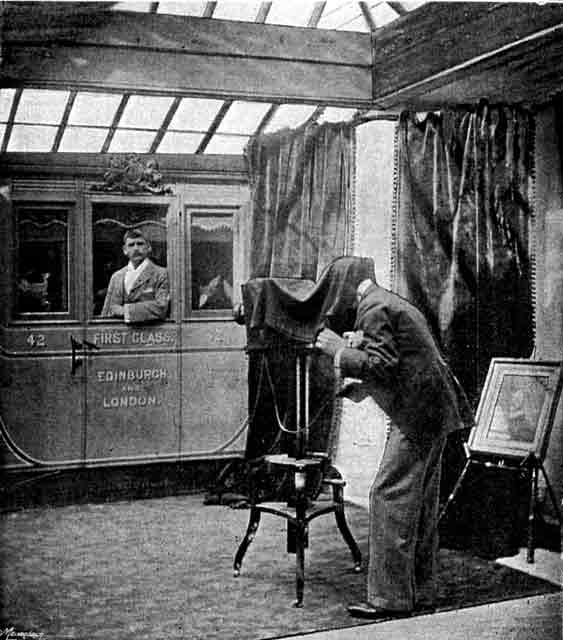
©
Reproduced by courtesy of
Edinburgh City Libraries and Information Services
Harper & Smellie
Leith Walk (1899-1908)
and Princes Street
(1902-1906)
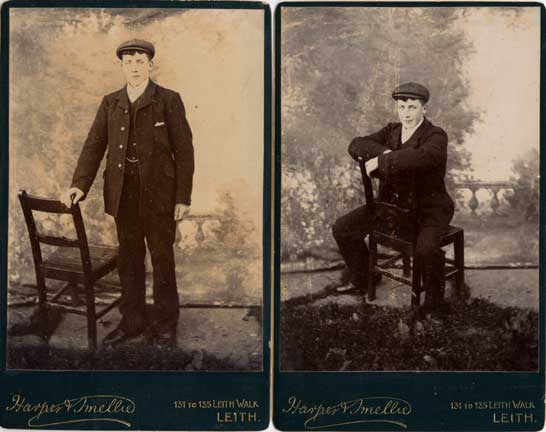
William Crooke
1883 -1929
-
William Crook was one of Edinburgh's most prominent
photographers. He won many awards for his photography.
-
He had studios in Princes Street from 1883 until 1929, with
rather more furniture than Harper & Smellie had above.
-
The studio must have looked impressive, with its outlook to
the south across Princes Street Gardens to Edinburgh Castle.
Princes Street Studio - 1911
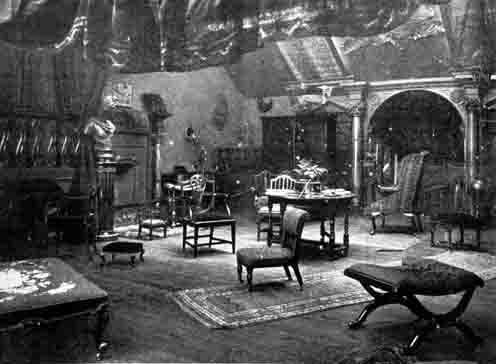
©
Reproduced by courtesy of
Edinburgh City Libraries and Information Services.
Princes Street Studio - 1911
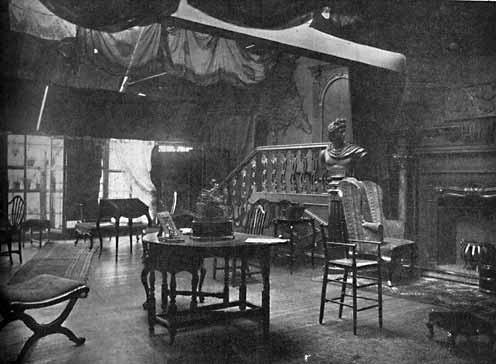
©
Reproduced by courtesy of
Edinburgh City Libraries and Information Services.
E R Yerbury
The Yerbury family had studios
in Edinburgh 1869 - 2003
-
Several generations of the Yerbury family have had studios in
Edinburgh, beginning with E R Yerbury who had a studio at the corner of
Princes Street and Hanover Street in the 1860s and ending with Trevor Yerbury
who had a studio in East Claremont Street and specialised in wedding
photography. His studio remained in business until 2003.
-
Here are some photos of the Yerbury family:
Three Generations
LEFT: Edward Reuben
Yerbury
[b.1843]
CENTRE: Edward Roper Yerbury
[b.1915]
RIGHT: Edward Reuben Yerbury
[b.1881]
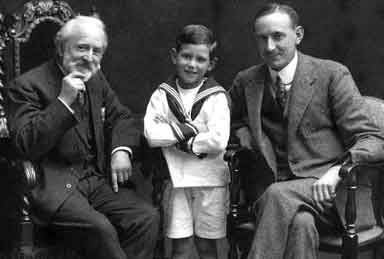
©
Reproduced by courtesy of
the Yerbury family.
Click here for link to web site.
Edward Reuben Yerbury
b.1843
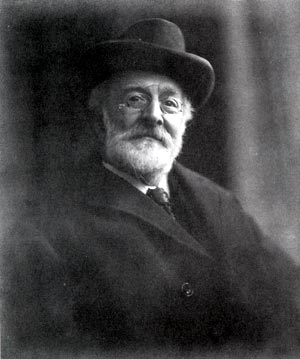
©
Reproduced by courtesy of
the Yerbury Family.
Edward Reuben Yerbury
b.1881

©
Reproduced by courtesy of
the Yerbury family.
Edward Roper Yerbury
1915 - 1949
Aged
about three
Photographed
by his father
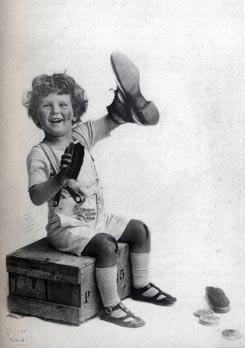
©
Reproduced by courtesy of
the Yerbury family.
Edward Roper Yerbury
1915 - 1949
'The Sky Pilot'
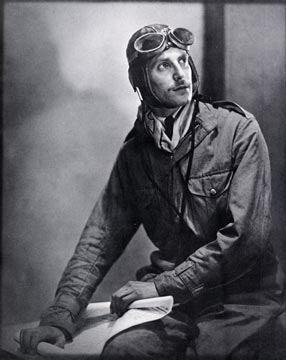
©
Reproduced by courtesy of
Trevor E R Yerbury, Edinburgh
Trevor Yerbury
1951 -

©
Reproduced by courtesy of Trevor
Yerbury.
Click
here for link to web site.
-
Yerbury photographers took over the businesses of several
prominent Edinburgh photographers:
-
William Crooke (1930)
-
JCH Balmain (1958)
-
Andrew Swan Watson (1958)
-
John Moffat (1962)
-
Here are some early images from the Yerbury collection, taken
in and around Edinburgh. The first was taken around 1850. I believe that most
of the others would have been taken by Balmain:
Cramond
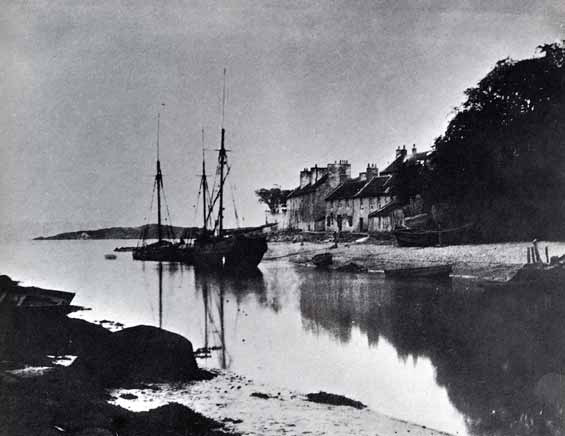
©
Reproduced by courtesy of the Yerbury
family. Click here
for link to web site.
Cramond
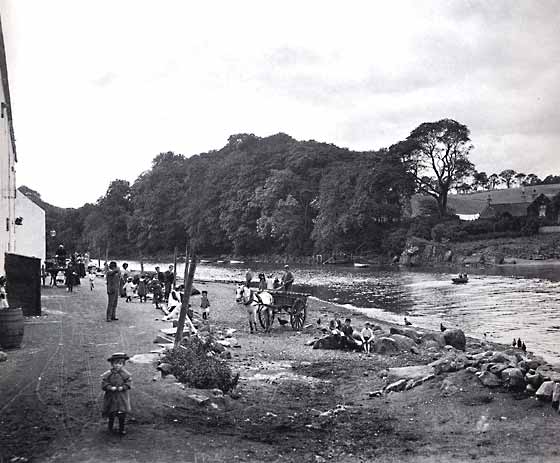
©
Reproduced by courtesy of the Yerbury
family. Click here
for link to web site.
Maule's Dept Store
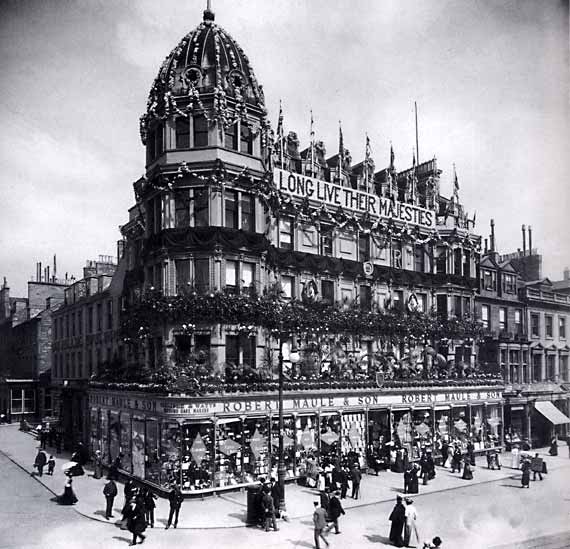
©
Reproduced by courtesy of the Yerbury
family. Click here
for link to web site.
St
Giles
-
High Street, Edinburgh
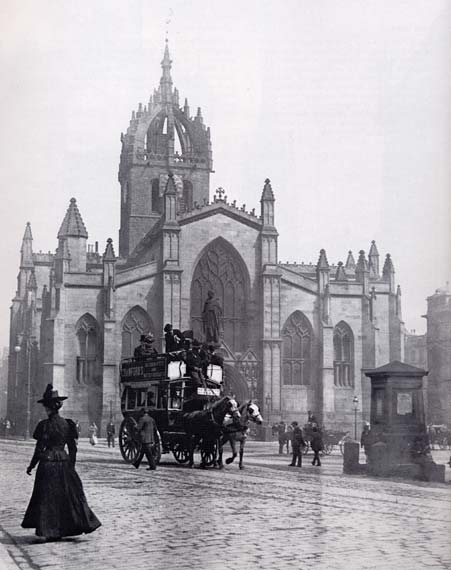
©
Reproduced by courtesy of the Yerbury
family.
Click
here for link to web site.
East End of Princes Street

©
Reproduced by courtesy of the Yerbury
Family. Click here
for link to web site.
West
End of Princes Street
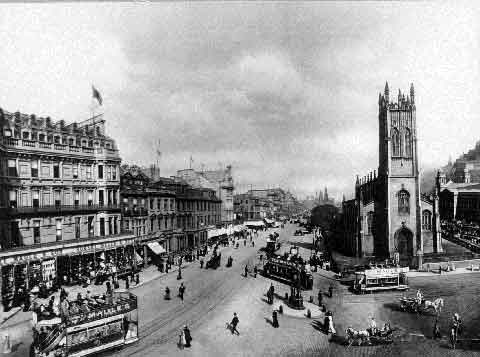
©
Reproduced by courtesy of the Yerbury
Family. Click here
for link to web site.
Elephant Parade,
North Bridge
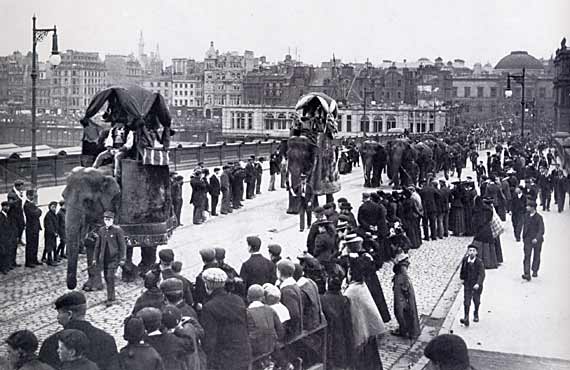
©
Reproduced by courtesy of the Yerbury
family. Click here
for link to web site.
-
Here are some photos of Edinburgh with an impressionistic
feel. They were created by Trevor and Faye Yerbury, using original
polaroid material. They were exhibited, together with some Yerbury images
from 1850 to 1950, in Ocean Terminal in 2004:
The Forth Rail Bridge

©
Trevor and Faye Yerbury,
Edinburgh
Newhaven Lighthouse

©
Trevor and Faye Yerbury,
Edinburgh
________________________________
Thomas Vernon Begbie
-
Thomas Vernon Begbie took many photos of streets and
views around Edinburgh that others ignored.
-
In 1950, his collection of
451 glass plate negatives of Edinburgh was found in an attic and rescued.
Here are a few of them
The Scott Monument
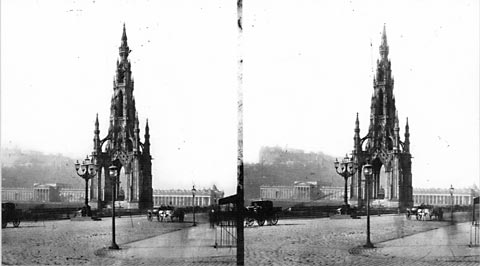
©
City Art Centre, City of Edinburgh Museums and Galleries
Waverley Bridge
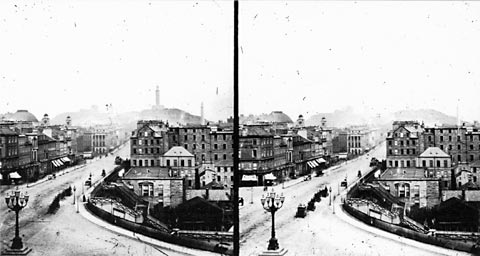
©
City Art Centre, City of Edinburgh Museums and Galleries
Leith Inner Harbour
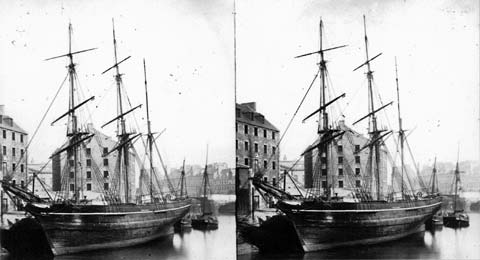
©
City Art Centre, City of Edinburgh Museums and Galleries
Leith Shore
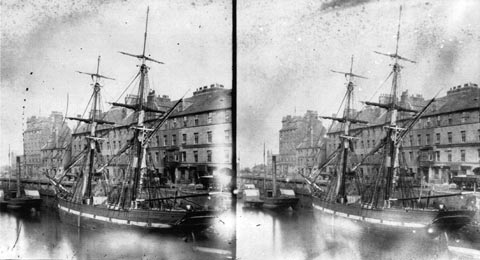
©
City Art Centre, City of Edinburgh Museums and Galleries
Canongate Tolbooth

©
City Art Centre, City of Edinburgh Museums and Galleries
Whitehouse
Close
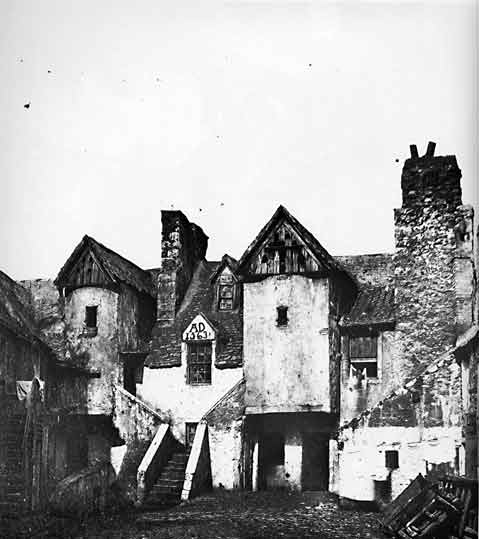
©
City Art Centre, City of Edinburgh Museums and Galleries
Demolition to enable Cockburn Street to be built
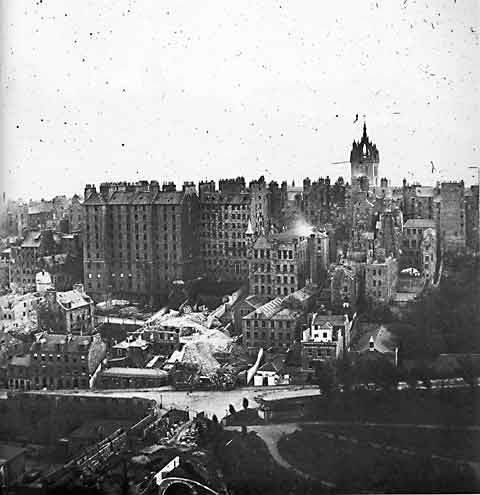
©
City Art Centre, City of Edinburgh Museums and Galleries
Leith Wynd
- leading from the Royal Mile to Leith Walk
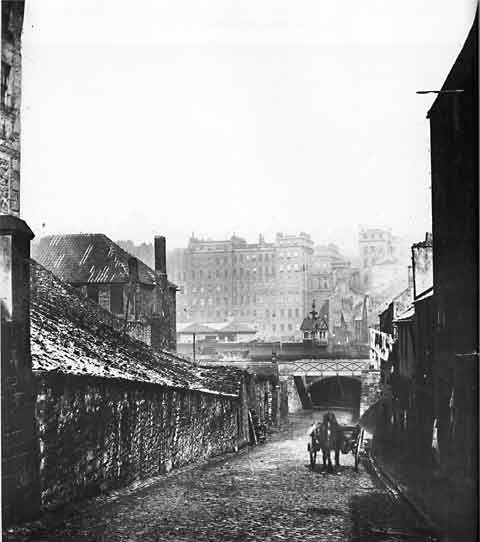
©
City Art Centre, City of Edinburgh Museums and Galleries
________________________________
Norward Inglis
-
Norward Inglis took still photos then, latterly, movies.
Most of his still photos were taken around the 1950s, about a century after
Begbie's photos above.
Norward Inglis
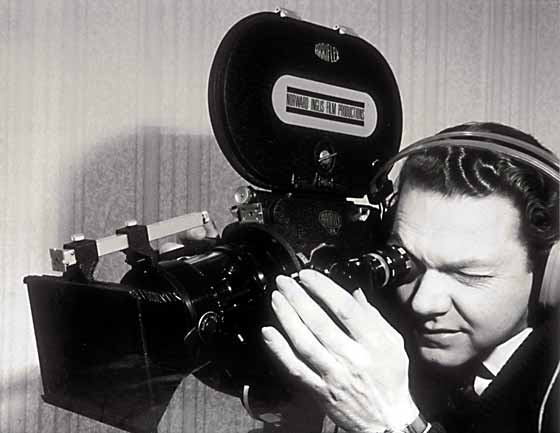
©
Copyright: Norward
Inglis and peter.stubbs@edinphoto.org.uk
Princes Street

© Reproduced
with acknowledgement to Norward Inglis and
Barbara Simpson
Edinburgh Castle
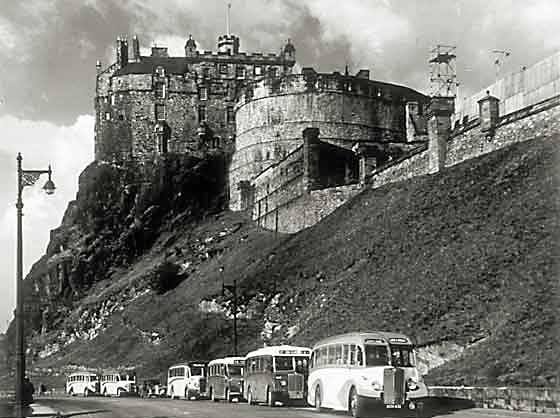
©
Reproduced
with acknowledgement to Norward Inglis and
his daughter, Barbara Simpson
George Street
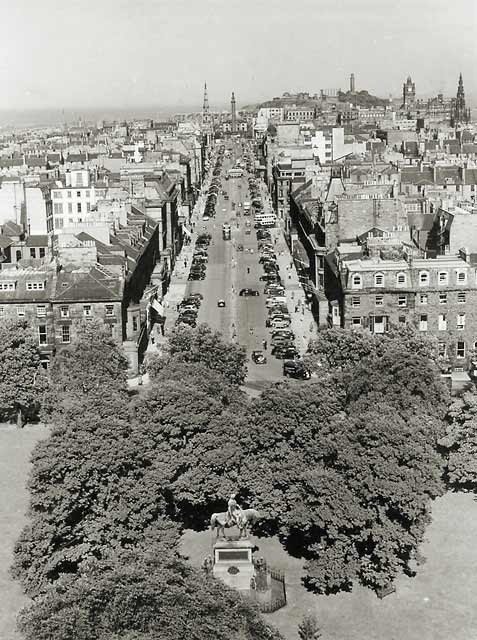
© Reproduced
with acknowledgement to Norward Inglis and
his daughter,
Barbara Simpson
Edinburgh Military Tattoo -
1950 - The second year of the Tattoo

©
Reproduced
with acknowledgement to Norward Inglis and
his daughter, Barbara Simpson
Holyrood Palace Gates
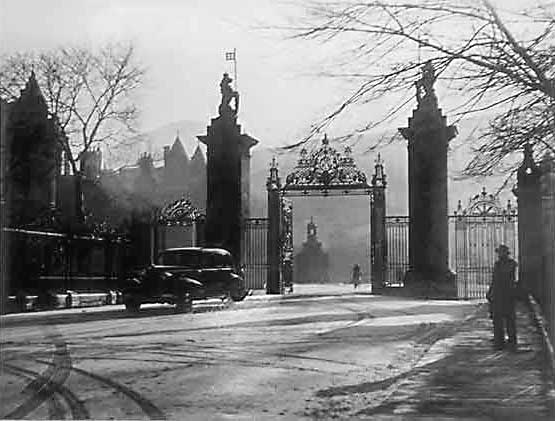
©
Reproduced
with acknowledgement to Norward Inglis and
his daughter, Barbara Simpson
Princes Street -
Looking West - What was the occasion?
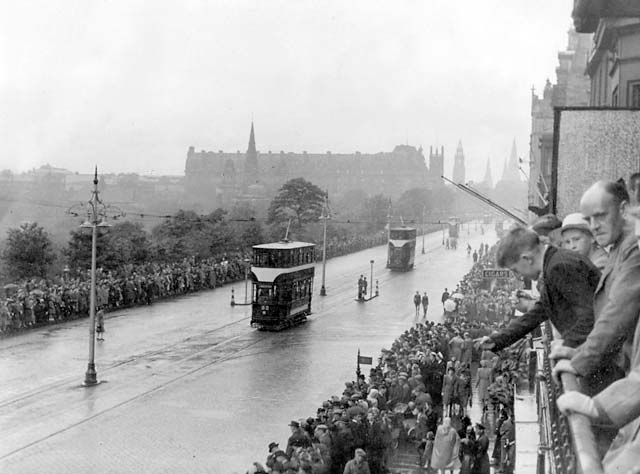
©
Reproduced with acknowledgement to John Stewart, Livingstone,
West Lothian, Scotland
Looking down on Dumbiedykes
from Salisbury Crags
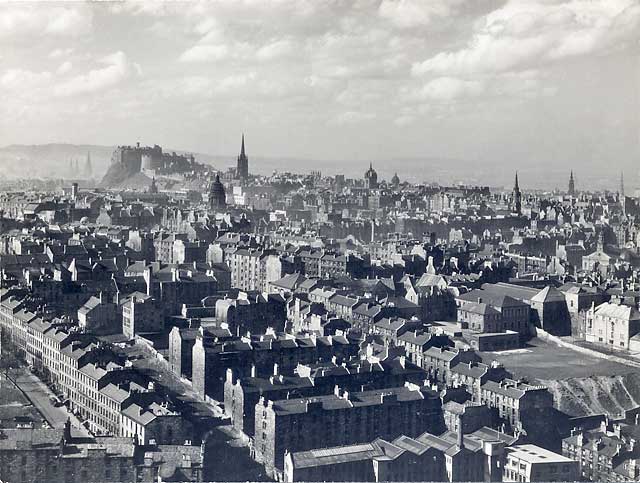
©
Reproduced
with acknowledgement to Norward Inglis and
his daughter, Barbara Simpson
-
Photos of Dumbiedykes have attracted a lot of interest
amongst people who lived there before the houses were demolished in the
1960s.
-
Here are a few more views of the area. These are
not taken by Norward Inglis:
The Scotchie, Dumbiedykes - 1959
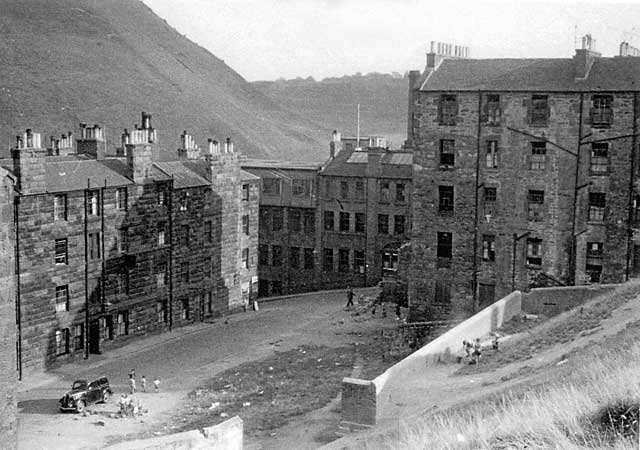
©
Reproduced with acknowledgement to Edinburgh City Libraries and
Information Services
Neg. A904A
Looking down on Dumbiedykes
from Salisbury Crags

©
Reproduced by courtesy of Evening
News. Click here
for web site details.
Clearing the Drains in Heriot Mount - 1959
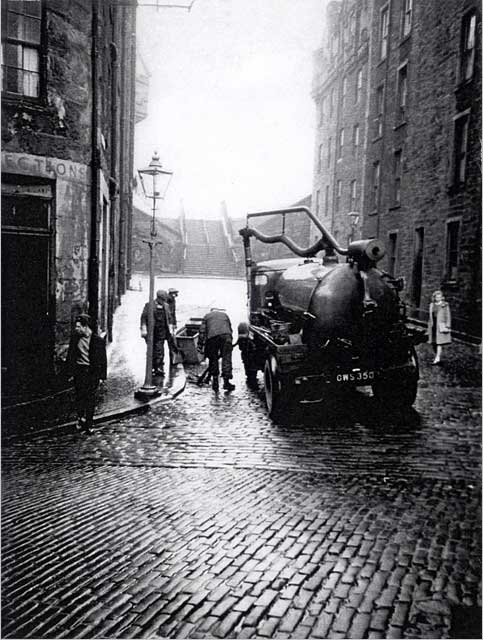
©
Reproduced with acknowledgement to Edinburgh City Libraries and
Information Services
[Ref S1014 D]
Arthur Place - 1959

©
Reproduced with acknowledgement to Edinburgh City Libraries and
Information Services
Neg. E932F
Three workers from William
Waugh Ltd, Metal Merchants - Late-1950s
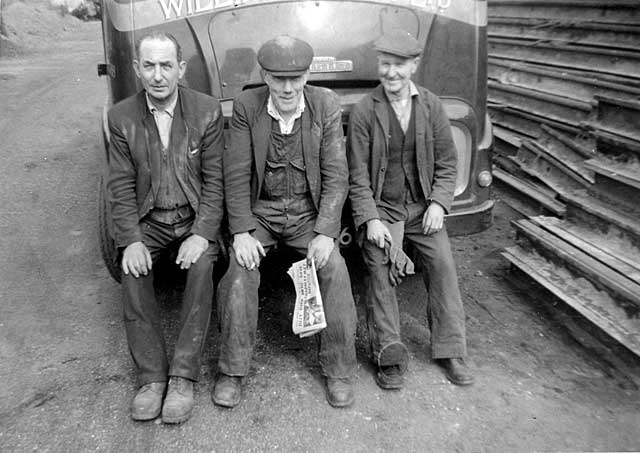
©
Reproduced with acknowledgement to Jean Rae,
daughter of Tom Aithie on the left of this picture
Top of Arthur Street - 1959
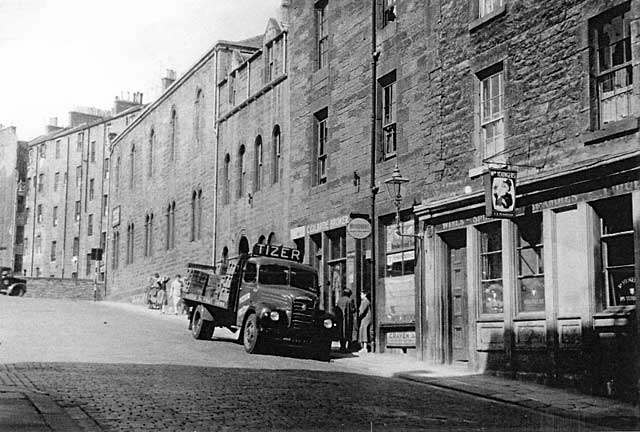
©
Reproduced with acknowledgement to Edinburgh City Libraries and
Information Services
Neg. F936C
Run-away Coal Lorry at
the foot of Arthur Street
- 1950s
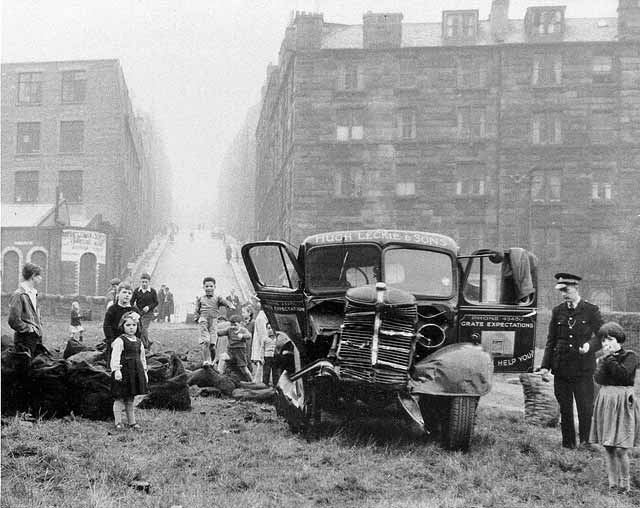
© Reproduced with
acknowledgement to Ron Leckie, California, USA |
